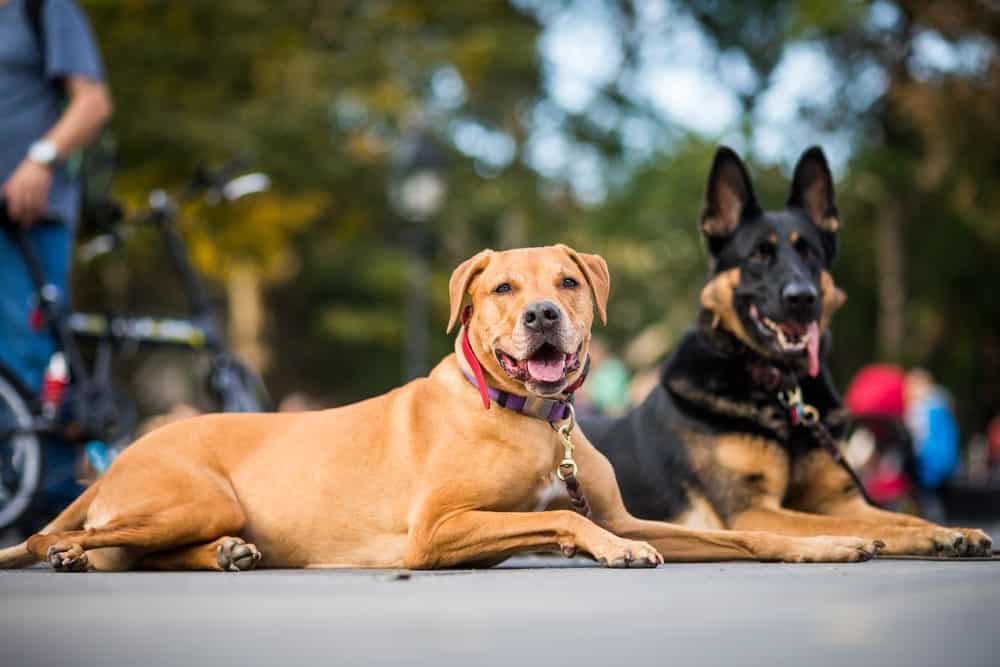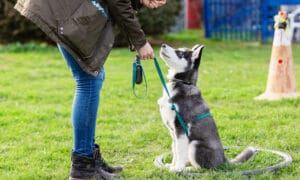“This post contains affiliate links, and I will be compensated if you make a purchase after clicking on my links.”
The Canine Good Citizen program was designed by the American Kennel Club to promote responsible dog ownership and to encourage pet parents to teach their dogs basic good manners and appropriate behavior. Today, certification is, for many dog owners, a badge of honor, but also an excellent starting point for parents of dogs entering therapy, assistance, or service dog work.

Who Can Become a Canine Good Citizen?
Any dog, of any breed or mix of breeds, at any age can become a certified Canine Good Citizen by successfully meeting a set of ten criteria established by the AKC.
The criteria, detailed below, demonstrate a dog’s understanding of basic good manners in a variety of situations, like greeting people and other dogs appropriately, reliably following obedience cues given by their owner, and the confidence to be handled, groomed, or examined by courteous strangers, like veterinarians and groomers – all important aspects of well-behaved dogs.
In order to be certified, an AKC approved evaluator will test the dog’s ability to perform ten different tasks. To become certified, the dog must pass all ten without fail. While it may seem difficult for new pet owners, or owners of rambunctious or unruly dogs, the process of training a dog to pass the test is both fun and rewarding, both for the dog and the handler!
In addition to training their dog to successfully pass the tests, pet parents must sign a Responsible Dog Owners Pledge, promising to provide the best care for the life of their dog.
The CGC Criteria:
In order to be named a Canine Good Citizen, dogs must be able to successfully, calmly, and confidently do ALL TEN of the following:
- Remain calm while a friendly stranger approaches, stops to talk to you, and shakes your hand.
- Remain calm while a friendly stranger approaches and pets him.
- Allow a stranger to handle him in the manner that a veterinarian or groomer would, looking at his ears, touching his paws, and brushing him.
- Walk nicely on a loose leash, without pulling, lunging, or trying to back out of his collar.
- Calmly walk alongside you on a loose leash as you navigate through a small crowd of people.
- Sit and lay down on command, then stay in either position while you walk 20 feet away.
- Come to you when called from a distance of 10 feet.
- Remain calm as another dog and handler approach.
- Show confidence and only mild interest while two separate distractions, such as loud noises, wheelchairs, joggers, or skateboarders are presented.
- Remain relatively calm under the control of another person after you pass them the leash and walk out of sight for 3 minutes.
Additional Guidelines:
In addition to passing the ten tests above, Canine Good Citizen certification requires a few additional rules and guidelines to be followed during testing. They are:
Equipment: During the CGC evaluation, dogs must wear a standard buckle collar, a slip collar, or a fitted body harness. Special training collars, like head halters, prong/pinch collars, electronic collars, or no-pull harnesses are not permitted during testing. While many of these items are effective training tools, a Canine Good Citizen should be able to perform the necessary tasks without training aids. Pet parents should bring their own brush or comb to the evaluation for testing. And, a 20’ leash will be used which is typically provided by the evaluator.
Rewarding Your Dog: During the evaluation, the use of treats, food, and toys is prohibited. You may talk to your dog, offer praise and attention, and give pets for a job well done, but food and toy rewards are not allowed. This rule is meant to prove to the evaluator that your dog willingly performs the required tasks whenever asked, not just because a treat is coming. However, while you’re training your dog for the test, please use rewards for reinforcement and to encourage great behavior.
Causes for Disqualification: In addition to passing all ten tests without fail, there are a few instances where dogs can be dismissed from the evaluation. Any dog that eliminates (pees or poops) during the test will automatically be disqualified. Make sure your dog hasn’t eaten a huge meal just before the test, and be sure he’s walked and pottied before beginning. Additionally, any dog that growls, nips, snaps, bites, lunges, attacks, or attempts to attack another dog or person will immediately be dismissed from the exam.
Even if pet parents choose to pass on the official certification, training your dog to perform the 10 tests above will build an excellent foundation of trust, reliability, and good manners that are necessary for a well-mannered, happy, and safe dog.
Could your dog pass the Canine Good Citizen evaluation?



















Martina Smith
Nov 29, 2019 at 5:39 pm
Great information, I actually complete first level of Dog training with Petco. I just need to complete level two training with my dog and he will be able to take the Canine Good Citizen test and become certified Canine Citizen. So hopefully by March of 2020, Tito should be certified.
Pingback: Could Your Dog Be A Canine Good Citizen? – Dog Training